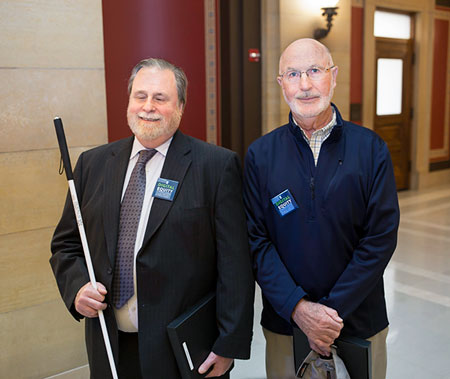SSB staff honored for their work
6/5/2019 12:30:00 PM
It took David Andrews, chief technology officer for State Services for the Blind, to ask the right question: Why is the State of Minnesota purchasing inaccessible technology?
Chuk Hamilton, former SSB director, helped define the problem through a comment/complaint website where feedback on state services and programs from all state agencies was solicited. Hamilton, along with others, also developed legislative strategies.
On May 7, Andrews and Hamilton joined nine advocacy champions and legislators on the dais at the Minnesota Capitol rotunda celebrating the 10th anniversary of the Digital Accessibility and Usability Law requiring all executive branch agencies to support a digital accessibility standard. The standard defined the ways in which digital information – websites, applications and documents – must be accessible so all Minnesotans, disabled or not, have equal access to state services and programs.
The Governor’s office, Office of Accessibility, Minnesota accessibility coordinators, and Minnesota IT Services gathered in a public celebration to recognize Andrews, Hamilton and others who worked to draft and pass the law.
“For those of who began working on this issue in the 1990s, it took a long time to gel,” Andrews said. “But DEED has always been at the table working with other agencies and taken a lead position in disability inclusion initiatives.”
After a recognition ceremony, participants could stop by an Experience Lab, interactive stations on vision, hearing, cognition, and motor control showcasing how people with disabilities use technology to read and understand information.
Although most people who are blind have some degree of vision, they do not use their eyes to access the web. A computer monitor and mouse are much less useful because they can’t see what’s on the screen. Most computer users who are blind rely on the keyboard for navigation and primary structural cues to understand the content. They also use screen reading, or screen magnification software to read what is on the screen.
Although most people who are blind have some degree of vision, they do not use their eyes to access the web. A computer monitor and mouse are much less useful because they can’t see what’s on the screen. Most computer users who are blind rely on the keyboard for navigation and primary structural cues to understand the content. They also use screen reading, or screen magnification software to read what is on the screen.
Photo credit: Jeremy DePew, MNIT
workforce